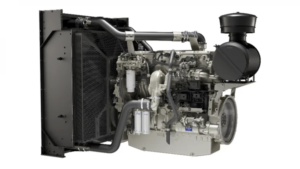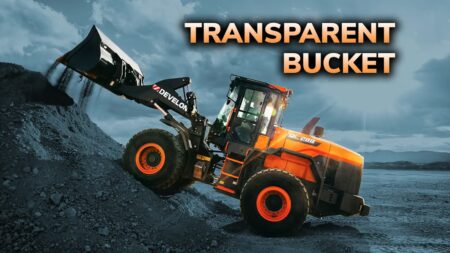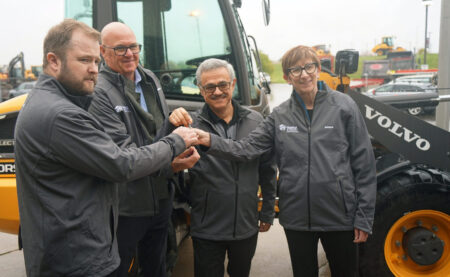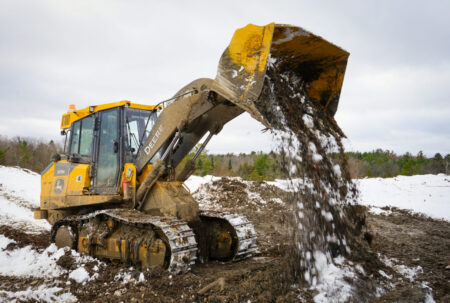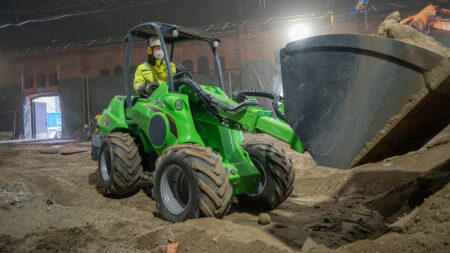Bryan Furnace (00:00):
Hi everybody. Welcome back to Equipment World. You’re watching The Dirt. I’m your host Bryan, and today we’re here to talk about Komatsu. More specifically, we’re here to talk about the WA475-10. The dash 10 is the newest series of wheel loaders from Komatsu and I recently had the pleasure of going to Atlanta to their customer center to go put one of the 475s through its paces to do a bit of a review. I will say this, just a disclaimer, it is at a customer center. At the end of the day, we are not on a job site and so there’s only so much I can do to put these machines through their paces and along those lines, I’m generally there reviewing more than one piece of equipment, which means I get pretty limited time in the machine.
(00:45):
So there’s only so much we can do here. The other caveat I want to put into this is I traditionally have always been an on-the-job site loader operator. I have either been on a road crew or a pipe crew. The WA475, while a lot of contractors use it in that application, it’s really geared more to be a yard machine at a pit or a quarry. And so you start to get in some features like the load metering system. I don’t have any experience in that realm and so this was all new to me. I may be razzle, dazzled and pizzazz by a feature that you yard guys just go, Bryan, that’s just a regular feature on machines, so bear with me in that space. But that being said, let’s get into the review.
(01:26):
I’d like to start the review with just a basic walk around of the machine. One of the things you’re going to notice just standing at a distance is Komatsu is starting to follow the other manufacturers in taking a little bit more time on the aesthetics of the machine. We are starting to see the exhaust pipe being covered by cowling to make it look a little nicer. The curves and contours on the machine are starting to become more curves and contours as opposed to just hard jagged lines. And so the machines are starting to look more futuristic, newer, they aren’t looking like just an old brick of iron like the old school machines used to. Now as operators, we all say that’s silliness, that material, it doesn’t add to the machine, but I can honestly say I do like that manufacturers are starting to think above and beyond just the practicality of the machine and they are starting to pay attention to aesthetics.
(02:12):
One of the other things you’re going to notice on this machine are some of the standard features that aren’t necessarily standard features for other manufacturers. The backup camera, the LED light package, the full fender package all the way around the machine, and my favorite part, heated and electric mirrors. So your mirrors are all electric. You can move them from inside the cab and they are heated. So guys like myself in the north don’t have to worry about getting out there in the cold to wipe off our mirrors. That’s a fantastic feature and it is standard on the Komatsu WA475. Great, awesome stuff. Now as we continue to walk around the machine, one of the things you’re going to notice too is the giant hood cowling on the back of the machine, as is typical with most loaders in the industry. Now the cool thing is Komatsu has made a bunch of small little doors so I don’t have to sit there for five minutes every morning waiting to raise the hood cowling so that I can check my dipstick.
(03:05):
Every single one of my morning checks is easily done with a small door that requires two fingers to open and is very easy to get to. That’s fuel, that’s depth, that’s your dipstick, and most of your filters are all going to be able to be accessed without having to raise the hood on the machine. Now when you do have to raise the hood, there’s a small switch in one of your boxes in the back of the machine. It will electrically raise the hood. Now what happens if you don’t have electric power? Through one of your small side doors Komatsu has added a module that allows you to use a cordless drill and a standard bit to start raising the hood and you can get it high enough that you can get some jumper cables onto your posts and restore electrical power to raise the hood the rest of the way.
(03:45):
So you do have the ability to raise the hood even if the machine doesn’t have electrical power and it doesn’t require unbolting the hood from the machine. Now, as we continue to make our way around, one of the things that stuck out to me as an operator, and I know you guys are going to appreciate this, Komatsu has included steps across the front boom linkage on the machine so that we can clean our windows. Nothing was more difficult than trying to finagle around mirrors and everything else, a way that I can stretch my arm as far as humanly possible to get that spot in the top of my windshield when there’s nothing to step on. Komatsu’s added the steps to where when you articulate the machine off to the left, there is a step right there in alignment with your little step as you get out of the cab and you can easily walk your way across the front of the cab all the way over to the passenger side of the machine.
(04:34):
And by the way, those big mirror arms that stick out can easily swing in and out so that you’re not having to uncomfortably duck down losing your balance. You can easily swing them out of your way, get around them and swing them back into place. Another really great feature, and I love that they’re starting to actually think about the practical things that we do as operators to maintain the equipment, something as simple as steps across the front is such a huge thing. Now as you move inside the machine, this is where you’re going to notice a big step forward in my mind with Komatsu. Now I do need to say I have not run a Komatsu loader in about eight years and the Komatsu loaders I was running felt very dated. The cabs were just old feeling. Well that is a night and day difference between the machines then and the machines now.
(05:20):
As you sit down in the seat, you’re going to notice that your armrests have about every adjustment you could ever dream of. You can go up, you can go down, front, back, you can actually change the angle that they sit. You have a phenomenal amount of customization in this machine when it comes to the comfort of the operator. The air ride seat itself, this WA475 has one of the most comfortable air ride seats I’ve sat in and it does feel like you are in a space station. I hit some pretty hard bounces in this machine. I was trying to run it back and forth to gauge ride control as well as the actual seat itself, and I don’t know that I bottomed that seat out once. So it’s a very well built air ride suspension seat and you’re not going to destroy your back if you do hit a good enough bump.
(06:00):
Now that being said, I always put the caveat in there. That means you as an operator have to know how to appropriately adjust an air ride seat, so we’ll just throw that out there. Everything in this cab is laid out really well to where you’re not craning your neck around a whole lot. We have all of our buttons right here on our side console like most loaders do now. But again, they’re low, easy to access. They’re within your site picture. Instead of me having to swing way over and look totally 90 degrees from where I’m normally looking. Even your rear view camera that is always on, on its own monitor is not requiring me look way up here. It’s almost at eye level, just slightly above eye level, and so everything is very, very easy to see in this cab.
Now, this is where I do have one of my small beefs with Komatsu. Of all of the manufacturers, Komatsu specifically has always stuck out to me that they are production machines. Komatsu is very focused on moving dirt and they don’t get caught up in the creature comforts. Now unfortunately, that has always meant for their wheel loaders there’s absolutely no room in the cab for your lunchbox and we as operators know that you don’t have to give me a lunchbox just for lunch. Probably going to need to fit dinner in there too. We like big lunch boxes. Unfortunately with this machine, it’s either going to be underneath your feet or it’s probably going to be strapped outside the cab somewhere. You can’t put it any place else and that’s always been one of my major complaints with Komatsu wheel loaders is I have to figure out what I’m going to do with my lunch.
(08:46):
The particular unit I was using had joystick steering, so I had my joystick off to the left-hand side. I had a twins stick joystick set up on my right. Now they do offer a steering wheel if you would prefer that. This is one of the first times I’d ever run a joystick steering wheel loader, but I can say after running this thing with the joystick, I don’t know that I’ll ever return to a wheel. I would way prefer the joystick. Komatsu still has the traditional controls that any other loader’s going to have, your boom kick outs for raising and lowering, return to dig with your bucket. Again, going back to my roots, since I’ve never been a yard guy, I don’t typically find myself using all of those kick outs and so I tend to operate manually, but you do have the ability to operate those and have them there.
(09:27):
They’re totally adjustable and just like we are used to, you push the button, hold it down and it will set your D tens. I’m going to be honest, I’m not a huge fan of twin sticks. I never have been and I know that’s going to upset the 50% of you in the loader industry that love twin sticks. We know we all butt heads guys. It’s all right. I’m not a twin stick guy. It’s always felt like I have to reach. It strains these tendons and ligaments in my hand and then with twin sticks, a lot of times those joysticks were hard enough that it was a little difficult to operate with your fingers. Komatsu has done a phenomenal job to where it is very light to touch, EH controls. It doesn’t require a huge spreading of the hands, and they were very, very comfortable. I got in this thing kind of regretting that it was a two stick machine. By the time I was said and done, I didn’t care.
(10:10):
It was totally comfortable to operate. I had no issues. If you get the auxiliary hydraulic circuit, that will just add a third stick one closer to the operator. So not on the outside of your sticks but on the inside of your sticks. Visibility on the machine out the front of the machine and the sides is great. I don’t have any complaints there. As we are seen with all of the new loaders that have all of the new emissions packages on them unfortunately, visibility out of the back of the machine isn’t really great. So Komatsu traditionally has the two smaller mirrors in the top right and left hand corners on the inside of the cab that would view over the hood of the machine out the back. Those are just about useless these days because of how large the hood is. Now you still have your side mirrors and we do have the addition of the reverse camera, so it’s one of those things where we aren’t giving up a tremendous amount of visibility, but there is still the problem that we are giving up some visibility there.
(11:02):
Now getting into the screen and the menus and how you navigate those. I’m a firm believer that if I am set up for the day in my machine, I’ve got my traction control where I want it. I have my boom bucket kick outs where I want them and I have everything dialed in. If I have to change anything beyond that point, it should all be adjustable at my controls. I shouldn’t have to take my hands off of my controls and put them somewhere else around the cabin, and that’s exactly what Komatsu’s done with their menu system. Just beside your twin sticks, you have a small knob that’s also like a joystick and that allows you to get into the menus without having to lean forward and actually interact with the screen. It’s just right here beside my twin sticks that I’m already using.
(11:41):
Now, another feature I really like is they’ve included two favorites buttons. So let’s say you have a couple menu items that you use all the time and you want to be able to get into quickly. Instead of having to manually find those items in the menus every single time, you can program these favorite buttons to immediately go to that menu. The example that was given to me that I thought was pretty brilliant is if you are in a pit or a quarry and you change materials and you have a different material density, instead of having to go through your menus to get to that page to change your density, you can set that to one of your favorites. It’s a one-touch button, make your adjustment and your back to work. The only two buttons I’m going to be using are actually on the sides of my twin sticks here, so my hands literally never have to leave the controls unless I need to go change materials densities.
(12:25):
I can do all of my resets and everything just from the buttons on my joysticks. So it’s a really intuitive layout and it’s very ergonomic. This also has an integrated load metering system. This is where we get out of my depth of knowledge a little bit because again, I’m not a yard guy, but the load metering system on this machine was very intuitive. It took all of two minutes of explanation and I was able to figure out exactly what I needed to do and in real time it’s measuring not only the load that you have on, but it has the ability to, if you tip off a little bit, it will show you in real time how much weight you’re tipping off. I absolutely love it. The only other complaint I have from an in cab environment is Komatsu’s menu system. From the beginning, my experience with Komatsu has been their buttons and their menu systems are not the most intuitive.
(13:11):
As a result, getting into Komatsu’s menu system always has been a little bit of a confusing endeavor for me, and it’s been difficult to remember exactly where items are unless I’m using them every day. This continues to be the case with Komatsu’s menus. They have their button system now that they have been with so long that I think it will be difficult for Komatsu to get away from that system, but I would over time like to see them come up with some new emblems and decals and some new nomenclature within the menus just because it is a little confusing. Now, getting into the actual operation of the machine, this is where this machine in my mind absolutely excels. Komatsu has a new Komatsu hydraulic mechanical transmission. Now, I’m no engineer and I can’t tell you how this thing works, but I will say what I was told is it is a hybrid between a hydrostatic transmission and a torque converter style transmission.
(14:01):
What I can tell you is as an operator, I absolutely love the transmission. It has the ability to give you that low RPM torque that we all love about hydrostat. It gives you a very smooth shuffle from forward to neutral to reverse as opposed to that very hard hitting gears engaging that you get out of a torque converter style transmission. Now that being said, one of my biggest complaints with hydrostatic transmissions is the fact that it takes away from hydraulic flow on the machine. So for instance, when I used to run my old WA320, or even going back to the days when I ran the Cat 938, you would be coming away from your pile, you’d be raising your boom arms up to get into your truck, and as soon as you switch from reverse to forward, all of a sudden your boom arms just stop until the hydraulic flow can keep back up again and then they start to move again.
(14:47):
With this machine, you don’t have that issue for two reasons. One is because of the way the transmission’s built, and two is because Komatsu has designed this machine to where the boom bucket and auxiliary circuit is totally separate from the transmission needs of the machine. And so I had no issue with any lag in any of my implements when I was in the middle of transitioning from reverse to forward or forward to reverse. It was constant and it was smooth. Now, another really great feature built into this machine that took some deprogramming on my part is the fact that the machine is monitoring how much power it needs to give you the hydraulic flow that you’re requiring. So in other words, it used to be if I wanted to raise my boom arms as fast as the machine could, I have to slam my D clutch pedal to the floor, I got to slam my accelerator to the floor, and then I’m going to crank back on that handle to raise the boom arms up.
(15:39):
This machine will automatically detect that you have pulled that stick all the way back and you want maximum hydraulic flow to the boom. Without you touching the accelerator pedal it will rev itself up to the correct rpm so you’re not wasting fuel and over revving and it will give you that flow until you let off, and then the engine RPMs will drop back down to whatever the machine needs for what the transmission is doing. So now that means I don’t have to mess with the D clutch pedal. I don’t have to slam the accelerator to the ground. So that means all I have to do is worry about what my wheels need to be doing on the ground and the machine is going to figure out whatever it needs to do to make the inputs that I’m giving it happen to my boom and bucket. That was a really, really cool feature about this machine.
(16:20):
This is also a really well-balanced machine. It was very, very easy to drive around with a loaded bucket and not feel tippy. It didn’t have a ton of sway to it compared to other loaders. It was just a very easy machine to run. It’s also got some additional features like the fact that it has anti rollback built in. So if you get stuck on a hill and you’re waiting for a truck to get out of your way or you’re waiting for somebody to dump off a load, instead of rolling back down the hill or having to sit there with your foot on the brake, the machine will actually engage its own brake and let you sit with your feet off of the pedals until you hit your accelerator pedal and then away you go. Another interesting feature is the fact that the transmission doesn’t have true gears.
(16:58):
This machine will never tell you what gear you’re in because technically it doesn’t have them. Instead, you have a dial on your right-hand side that reminds me a lot more of the dial that’s in an excavator, but you’re regulating the top speed of the machine, and so instead of regulating whether you go through one gear, two gear, three gears, or four gears, you’re actually just almost like a rheostat dialing down how fast you want to be able to go. Now, I personally will run the machine all the way out on fourth, and then I will dial it back with my foot pedal as needed. Now, where you can get into using this thing a lot more is in a pit or a quarry situation where you’re going down a lot of hills. That knob will also act like a retarder for the machine and it will slow the machine to whatever your selected top speed is as you go down that hill, that’s going to save you on your service brakes, which in my mind, that’s a great thing.
(17:45):
So overall, I absolutely love the WA475. My biggest complaint by far and away about this machine is the lack of ability to have my lunch in the cab with me, and I’ve got to be honest, if that’s my biggest complaint about a machine, that’s a pretty solid machine. We are all familiar with Komatsu and everything indicates that this machine is right in line with the tradition of Komatsu putting out really, really solid equipment. But in my mind, they have now brought the cab and the features and the creature comforts up to the bar that everyone else has set. This is a really, really solid machine. So I would like to say a big thank you to Komatsu for having us out. I hope this has been helpful if you’re thinking about looking into the WA475-10. Thanks for watching and we’ll catch you on the next episode of The Dirt.
Read the full article here


